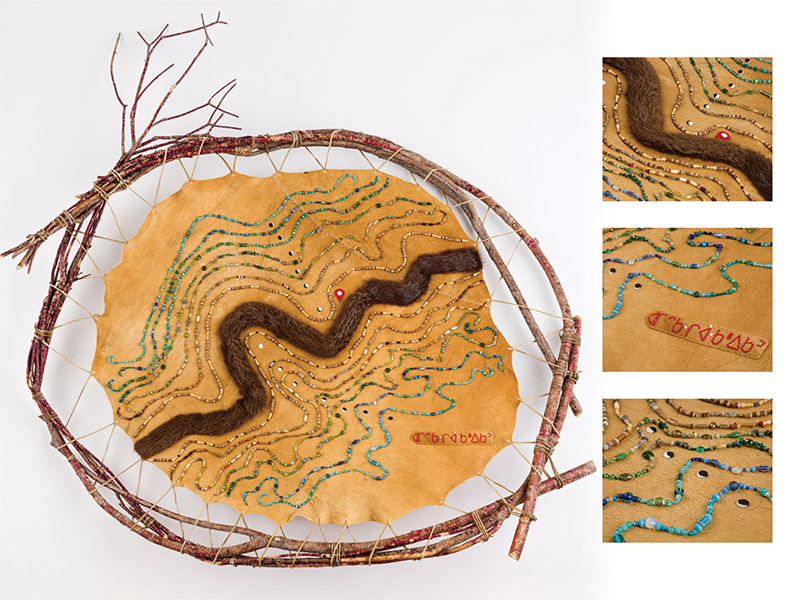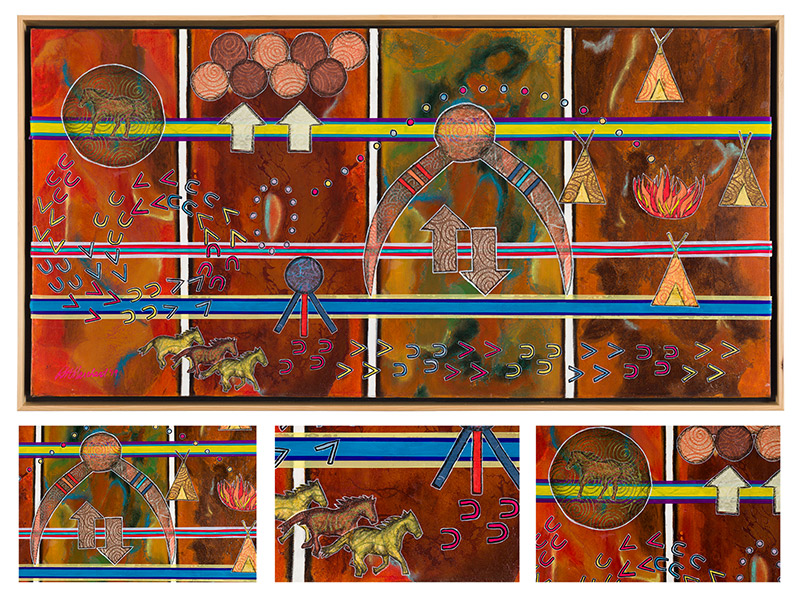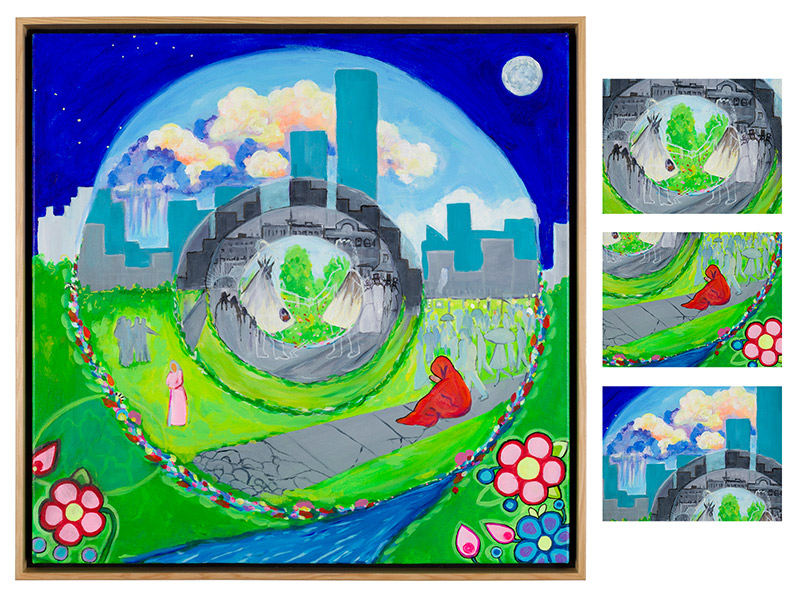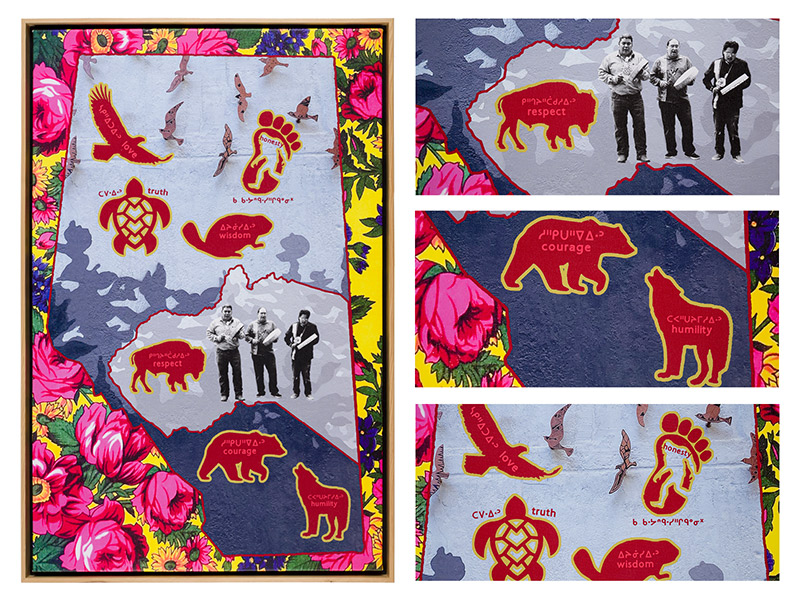Indigenous art helps tell stories, starts conversations and makes us look beyond our own experiences to better understand the lives, experiences and perspectives of Indigenous Peoples.
Indigenous Elders and Knowledge Keepers challenged City staff to move out of their heads and into their hearts. The City met this challenge by engaging Indigenous artists to help us to connect to our human side of empathy and compassion.
About the Artists
Artists MJ Belcourt, Brad Crowfoot, Dawn Marie Marchand and Lana Whiskeyjack each attended a community circle dialogue to capture the spirit of the conversations and tell a story in a visual art piece.
The collection of Indigenous Framework Artworks embodies how City leaders and staff live out the Indigenous Framework - how to be a good relative to each other and the land.

Title: “ᐊᒥᐢᑲᐧᒋᐋᐧᐢᑲᐦᐃᑲᐣ”a
Artist: Melissa-Jo (MJ) Belcourt Moses
Indigenous Peoples were instrumental to the success of the fur trade. This art piece is titled ᐊᒥᐢᑲᐧᒋᐋᐧᐢᑲᐦᐃᑲᐣ Amiskwaciy-wâskahikan (Cree), translated as Beaver Hills House, the Indigenous name for this land or area known today as Edmonton.
The materials used for this artwork are gifts from Mother Earth - the land and animals - which represents the theme and importance of reciprocity in relationships with each other and these earthly gifts.
The red willow that frames the moose hide is traditionally used in ceremonies such as talking circles. It is a symbol of communication and signifies the importance of connecting and speaking from our hearts. The central focus of this piece is the North Saskatchewan River Valley. The river of fur, symbolizing the fur trade era and Fort Edmonton HBC trading post.
Adhesion to the Treaty was signed in or near the original Fort Edmonton in 1877. Edmonton would not exist today without the achievements and contributions of Indigenous Peoples to the development of this region.

Title: City as an Advocate (Mixed Media Painting)
Artist: Dawn Marie Marchand
The overall theme of advocacy illustrates steps the City can take to live out the Framework. Several symbols such as horses and hoof prints symbolize concerns and barriers brought forward by Indigenous community members, like the need for financial support and sustainable funding.
The movement of horses, for example, represents how the City must collaborate with Indigenous communities in Edmonton to ensure actions reflect diverse voices and perspectives.
Other symbols like the circles represent the need for continuous education and training and self-reflection of personal beliefs, attitudes and assumptions, leading to action against racism towards Indigenous Peoples. The intent of the artwork is for City staff to put these teachings into practice in the workplace.

Title: "pisiskapahtam"
Artist: Lana Whiskeyjack
In PISISKAPAHTAM (to notice and observe or watch), the centre circle represents a lens in which the viewer becomes a witness, shares the relationship of ayisiniwak (beings of this land) continues to have with Mother Earth since prior to Treaties and colonization.
The tipi belonged to the woman, the mothers and grandmothers - the home fires of family, community and Nation. The tipi reflects the leadership position women had within their communities prior to the Indian Act, which removed women from their traditional roles of governance, justice, education, health and nurturers of kinship. The Indian Act is one of the most racist systemic laws that governed all levels of ayisiniwak that created the rippling influence of oppressive and violent treatment of ayisiniwak within the growth of Edmonton, which is reflected in the black and white image.
At the community engagement event, I heard many ayisiniwak community members share their stories that as the city grew, so did the poverty and mistreatment of many ayisiniwak by the Edmonton leadership and community members.

Title: “Heart Beat of a Nation”
Artist: Brad Crowfoot
Honouring Edmonton’s connection with the First Peoples of this land. Treaty 6 is outlined over the provincial boundary map of present-day Alberta to illustrate the spans of these ancestral lands.
The floral kohkom (grandmother in Cree) scarf around the map represents the Treaty colours: Green (grass), Blue (river) and Yellow (sun), signifying that Treaty is forever: for as long as the sun shines, the grass grows, and the river flows. Within Treaty 6, there’s a photo of Poundmaker Singers captured at the unveiling of a sculpture and a Treaty 6 marker at MacEwan University to highlight the responsibility that all Edmontonians have as Treaty people.
To honour the relationships that the City is building with Indigenous artists, the map features a sculptural mural by Métis artist Destiny Swiderski titled Amiskwacîw Wâskâyhkan Ihâtwin, located at the gateway to Beaver Hills House Park.
Finally, throughout the piece, the seven animals symbolize sacred teachings of relationships built upon principles of wisdom, love, respect, courage, honesty, humility, and truth.
The logo is a circle, drawing from the medicine wheel and tipi teachings of various Indigenous tribes. It represents Mother Earth as the ultimate connector of kinship. It is surrounded by 13 smaller circles to represent the tipi poles - this is our home.
They also represent the sun and moon cycles. Cutting diagonally across the circle is a blue line representing the North Saskatchewan River as it flows through Edmonton - Edmonton’s location is not by accident, as it is the water that has brought us all to this gathering place for thousands of years.
The different shades of green represent the land and the different colours represent the treaty principle “...as long as the sun shines, the rivers flow, and the grass grows.”
Other Indigenous Art Resources
Indigenous Artist-in-Residence Program
The Indigenous Artist-in-Residence Program showcases the artwork of talented Indigenous artists.
Indigenous Art Park
Queen Elizabeth Park has served as a destination park for Edmontonians since 1909 and provides amenities such as year-round trails, picnic areas and a playground.
Downtown Art
Public Art enhances and creates special public places, bringing people of all demographics together to build communities and connect. Murals, sculptures, public art, iconic architecture and grand landscapes create a more interesting and vibrant Downtown.
Art and ETS
ETS has some fabulous works of art throughout the Edmonton Transit system.


